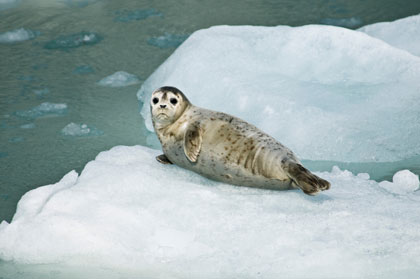In 2004, Tracey Goldstein was trying to crack a marine mammal mystery. Goldstein, associate director of the One Health Institute at the University of California, Davis School of Veterinary Medicine, was part of a team digging for answers about why Alaska’s northern sea otter populations were plummeting.
The falling number of otters was curious. Before the decline began, decreases in otters being killed for the fur trade had actually sparked a population rebound, Goldstein said.
Researchers still don’t know exactly what made the otter populations dwindle. However, Goldstein was shocked by something she and her colleagues discovered while screening the animals for a variety of diseases. Some of the animals had been exposed to phocine distemper virus (PDV), which is pathogenic for pinnipeds and is closely related to the measles virus and the canine distemper virus.
Same Virus, Different Location
This wasn’t the first time researchers identified a PDV outbreak in marine mammals. An estimated 23,000 European harbor seals were killed after they were sickened by the virus in 1988. In 2002, a second epidemic hit the northern Atlantic Ocean, killing approximately 30,000 harbor seals.
In 2004, scientists confirmed the first instance of a phocine distemper virus outbreak in the northern Pacific Ocean.
However, this was the first time a PDV outbreak was confirmed in the northern Pacific Ocean.
Northern sea otters “don’t move widely,” said Goldstein, so the emergence of PDV in the Alaskan population “really surprised” her and her colleagues. Researchers realized the virus was likely transmitted to the otters by some species of marine mammal that had contact with European harbor seals exposed to the virus. “Nomadic Arctic seals with circumpolar distributions (e.g. ringed and bearded, Erignathus barbatus, seals) and geographic ranges that intersect with those of harp seals, may be carriers of PDV to the North Pacific,” researchers wrote in Scientific Reports.
This explanation presented one big problem: Contact between Arctic and sub-Arctic seal species was assumed to be impossible due to Arctic sea ice separating the species. This left the team wondering whether there could be a connection between the rapid melting of Arctic sea ice, driven by climate change, and the emergence of PDV in the otters.
Boundaries Melting Away
In an international study conducted between 2001 and 2016, Goldstein and her colleagues probed connections between virus transmission patterns and environmental factors to understand when and how PDV was introduced into the North Pacific.
“The study is ambitious in its interdisciplinary effort to summarize immunological data on prevalence of antibodies to PDV, molecular data on the PDV-strain and data on animal behavior and migration patterns” with ice extent data, Karin Hårding, an associate professor of biology and environmental studies at the University of Gothenburg in Sweden, wrote in an email to Eos. Hårding wasn’t involved with the study.
Researchers collected nasal swab and blood samples from 2,530 live animals, including northern sea otters, ice-associated seals (including bearded, ribbon, spotted, and ringed seals), northern fur seals, and Steller sea lions. They also collected blood and tissue samples from 165 dead animals found on beaches or that people had hunted for food. The researchers then screened the samples for active infection and the presence of antibodies, which signify past exposure.

In addition, researchers “incorporated satellite telemetry data from ongoing ecological studies of seals and Steller sea lions, which provided a unique opportunity to combine animal movement and epidemiologic data to understand the potential spread of PDV,” they wrote.
The scientists noticed two spikes in Pacific PDV exposure and infection: one from 2003 to 2004 and another in 2009. August or September of 2002 and 2008 were months with reduced amounts of Arctic sea ice, resulting in water routes opening between Russia’s Arctic coast and the Pacific Ocean.
Furthermore, in both 2001 and 2007, “sea ice blocked passage through at least part of the Arctic Ocean bordering Russia’s coast,” the researchers noted. “When controlling for animal group and age class, presence of an open water route along the northern Russian coast following a year in which the Arctic sea ice along the Russian coast was closed was significantly associated with PDV exposure or infection,” they added.
Researchers may have documented a connection between reduced sea ice coverage and the emergence of a virus in a marine mammal species.
Goldstein thinks the PDV case provides the first documented connection between reduced sea ice coverage and the emergence of a virus in a marine mammal species.
Hårding was more cautious. The relationships between phenomena like ice coverage of the Arctic basin and the prevalence of antibodies “will always be correlations but do not prove causal relationships,” she wrote. “However, the authors do not claim [causation]. They just highlight interesting patterns that coincide,” she added.
As sea ice continues to melt in this warming world, will marine species be exposed to other diseases from which they were previously isolated? Only time will tell, but “it has happened once and there’s likely going to be the opportunity for it to happen again,” Goldstein remarked.
—Rachel Crowell (@writesRCrowell), Science Writer
Citation:
Crowell, R. (2019), Will melting sea ice expose marine animals to new diseases?, Eos, 100, https://doi.org/10.1029/2019EO137778. Published on 16 December 2019.
Text © 2019. The authors. CC BY-NC-ND 3.0
Except where otherwise noted, images are subject to copyright. Any reuse without express permission from the copyright owner is prohibited.

